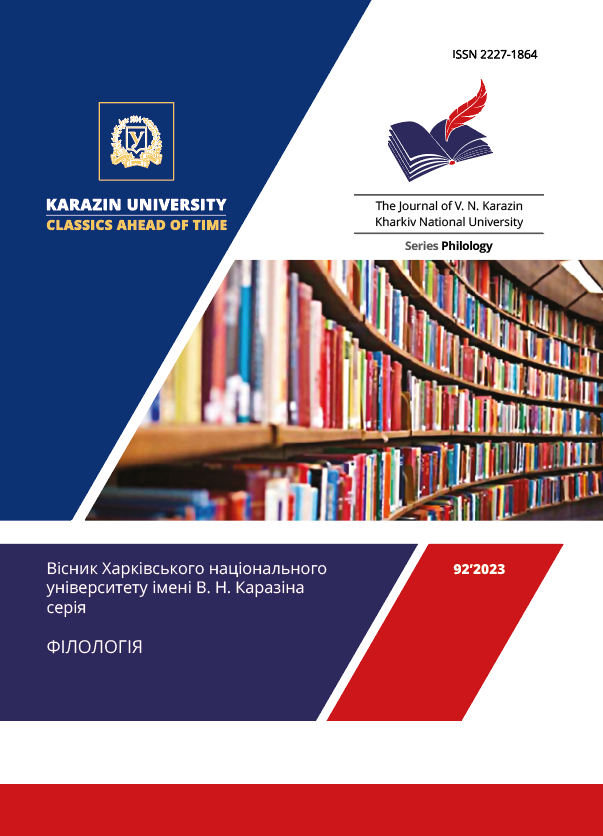Contrastive analysis of linguocultural connotations of zoonymic imagery in English, Ukrainian and Russian proverbs
Abstract
The use of contrastive analysis as a linguistic research method is effective at all language levels, especially at lexico-semantic and lexico-phraseological levels. Zoonymic images fixed in the language are associated with national and cultural stereotypes, value standards, which testifies to the individuality of the figurative thinking of speakers of the language, as well as to differences and similarities of language worldview.
The article presents a contrastive analysis of the linguocultural connotations of zoonymic images in English, Ukrainian, and Russian proverbs.
In the analyzed languages, the imagery of the proverb with a zoonymic component is formed by two main ways: as the figurative meaning of the whole sentence with the direct meaning of its component parts; as the figurative meaning of the parts of the sentence with the figurative meaning of the whole sentence.
The following types of formal similarities and differences in English, Ukrainian, and Russian proverbs with a zoonymic image are identified: full logical and figurative similarity; logical and figurative similarity at the level of the whole statement and differences at the level of words; identity of logical meaning and complete difference in imagery; similarity of imagery and differences of logical meanings. Similarities and differences in zoonymic imagery are explained by a number of reasons: differences in folklore imagery system; differences in the national and cultural systems, which are reflected in proverbs; borrowing images from well-known religious or literary texts; typological and areal similarities and differences of the figurative systems.
In various languages, the symbolic meaning of zoonyms is based on the importance of a certain animal, bird or insect in economic activity, in social and everyday life, in the mythological and religious worldview of the people. Specific examples (bull / ox; бик /віл; бык / вол) show that zoonymic images in different languages can completely coincide in their semantic meaning, be similar, or completely different. Zoonyms are formed according to mental patterns based on metaphorical transference and have evaluative and linguocultural connotations.
Downloads
References
Andreychuk, N. I. (2015). Contrastive linguistics: study guide. Lviv: LNU named after Ivan Franko. 343 p.
Vandepitte, Sonia & Sutter, Gert De. (2013). Contrastive linguistics and Translation Studies. Handbook of Translation Studies. Volume 4, pp. 36–41. Translation: 2021. DOI: https://doi.org/10.1075/hts.4.con4
Venzhinovych, N. F. (2018). Phrases of the Ukrainian literary language in the context of cognitology: monograph. Uzhhorod: FOP Sabov A. M. 463 p.
Vyrgan, I. O., Pylynska, M. M. (1959). Russian-Ukrainian dictionary of fixed expressions / elaboration of the text by Anatoly Yevpak; [last updated 06/15/2010]. URL: https://r2u.org.ua/data/Російськоукраїнський%20словник%20сталих%20-виразів%20%281959%29.pdf
Hryhorenko, T. V. (2010). Ethnographic vocabulary and phraseology as part of the Ukrainian literary language: a monograph. Uman: PP Zhovtyy. 216 p.
Dubravska, Z. R. (2018). Zoonyms as separate lexical units and as components of fixed expressions. A young scientist. Kherson: Helvetica. No. 3.1 (55.1). P. 51–53.
Kochergan, M. P. (2006). Basics of comparative linguistics: a textbook. Kyiv: Academy. 424 p.
Kryzhko, O. A. (2019). Figurative-nominative and evaluative characteristics of folkloric zoosemisms of the Ukrainian language. Scientific works of Kamianets-Podilskyi National University named after Ivan Ohienko. Philological sciences. Kamianets-Podilskyi: Axioma. Vol. 49. P. 80–85.
Levchenko, O. P. (2005). Phraseological symbolism: linguocultural aspect: monograph. Lviv: Region. Institute of State example National Acad. state example under the President of Ukraine. 377 p.
The proverb does not pass by – There is no proverb without truth: dictionary: Russian proverbs and sayings with Ukrainian correspondences / emphasis. N. Belenkova. URL: https://shron1.chtyvo.org.ua/Belenkova_N/Ros_pryslivia_- ta_prykazky_z_ukr_vidpovidnykamy_interakt.pdf?
Romanyshin, N. I. (2010). Contrastive stylistics of English and Ukrainian languages: Synopsis of lectures for students of the basic direction "Philology" of the specialty "Applied Linguistics" of the educational qualification level "Bachelor". Lviv: Publishing House of Lviv Polytechnic. 140 p.
Semenova, O. V. (2018). Semantic-pragmatic peculiarities of zoophraseologisms. Zakarpatski Philological Studies. Uzhhorod: "Helvetika" Publishing House. Vol. 1. Issue. 7. P. 112–115.
Chayenkova, O. K. (2020). Phraseological units with the zoonym component "horse" (based on Ukrainian, Turkish and English materials). Language. No. 33. P. 132–137. DOI: http://dx.doi.org/10.18524/2307–4558.2020.33.206543
Shmiger, T. (2009). History of Ukrainian translation studies of the 20th century. Kyiv: Smoloskip. 342 p.
Stompel, H. V. Comparative and stylistic analysis of verbs "to know" in multilingual artistic texts. eaKirNTU (Electronic archive Kirovograd National Technical University). URL: https://core.ac.uk/download/pdf/81588495.pdf
Apperson, G. L. [et al.]. (2006). The Wordsworth dictionary of proverbs. Hertford-London, Wordsworth editions Ltd. 656 p.
Asimopoulos, P. (2019). A contrastive analysis of phraseologisms with the zoonym “Cat” in Bulgarian, Greek, Russian and Serbian. Studii si Cercetari de Onomastica si Lexicologie. Vol. 12. №1 (2). P. 134–156.
Bugarski, R. (1997). Language from mira do rata. Beograd: Beogradski krug. 3rd ed., Beograd: Čigoja štampa / XX vek. URL: https://ru.scribd.com/document/238156960/Jezik-i-Kultura-Ranko-Bugarski
Bundy, R. (2020). Phraseological units with zoonyms: a look through the window of cultural influence. Language in (Dis) course. Vol.
P. 307–319. 20. Citrona, F., Cacciari, C., Funcke, J., Chun-Ting Hsu, Jacobs, A. (2019). Idiomatic expressions evoke stronger emotional responses in the brain than literal sentences. Neuropsychologia. Vol. 131. Pp. 233–248. DOI: https: 10.1016/j.neuropsychologia.2019.05.020
Fiedler, S. (2017). Phraseological borrowing from English into German: Cultural and pragmatic implications. Journal of Pragmatics. Vol. 113. Pp. 89–102. DOI: 10.1016/j.pragma.2017.03.002
Furiassi, C. Macaroni. (2018). English goes pragmatic: False phraseological Anglicisms in Italian as illocutionary acts. Jornal of Pragmatics. Vol. 133. Pp. 109–122. DOI: 10.1016/j.pragma.2018.02.009Get rights and content
Speakers, J. (2008). The Oxford dictionary of proverbs, 5th edition. Oxford University press, NY. 388 p.
Sprenger, S. A., Levelt, W., Kempen, G. (2006). Lexical access during the production of idiomatic phrases. Journal of memory and Language. Vol. 54. Pp. 161–184. DOI: 10.1016/j.jml.2005.11.001.




